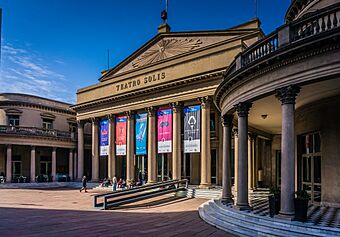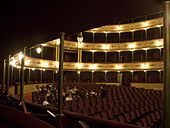Solís Theatre facts for kids

Teatro Solis in 2016
|
|
| Address | Buenos Aires 678 Montevideo Uruguay |
|---|---|
| Owner | Government of Montevideo |
| Type | Municipal (Montevideo) |
| Capacity | 1500 |
| Current use | Opera, Ballet, Concerts, Plays |
| Construction | |
| Opened | 1856 |
| Renovated | 1996 - 2004 |
| Years active | 161 |
| Architect | Carlo Zucchi Francisco Xavier Garmendia Víctor Rabú |
The Solís Theatre (in Spanish, Teatro Solís) is a very important and famous theater in Uruguay. It first opened its doors in 1856. An Italian architect named Carlo Zucchi designed the building. You can find it in Montevideo's Old Town, right next to the Plaza Independencia. The theatre got its name from an explorer called Juan Díaz de Solís. He was the first European to explore the area that is now Uruguay.
In 1998, the government of Montevideo started a big project to rebuild and improve the theatre. This project finished in 2004, and the theatre reopened in August of that year. Experts made sure the sound inside the theatre was perfect after the renovation.
The first opera from Uruguay, called La Parisina by Tomás Giribaldi, was performed at the Solís Theatre on September 14, 1878.
Contents
History of the Solís Theatre
How the Idea Started
In 1833, a group of important people in Montevideo decided they wanted to build a new theatre. They formed a special committee, led by Francisco Margariños. By 1840, the government approved their plan to build the theatre. A board of directors was set up to manage the construction, with Juan Francisco Giró as its leader. Other notable citizens were also part of this board.
The committee's first meeting was on June 16, 1840. Their dream was to create a cultural center. They wanted it to be a place where people could enjoy art and feel a sense of community. It was meant to show the free spirit of the new country, the Eastern State of Uruguay.
Building a grand theatre was also a way for people to gather and show their social standing. It was seen as a place where important people could meet and enjoy cultural events together. This new theatre would offer a special place for the city's leading citizens to socialize.
Choosing the Best Location
In August 1840, the Italian architect Carlo Zucchi showed his plans for the theatre. He also suggested different places where it could be built. He looked at three main areas around the city.
Zucchi thought carefully about where the theatre should be. He knew the location would affect how the building looked and worked. He considered things like how the stage would be set up and how water systems would work. He also thought about the type of soil and how it would affect the building's foundation.
After looking at all the options, Zucchi preferred one specific area. However, he noted that this spot had some uneven land. He then focused on another option, which would need some digging work. This area had a natural dip in the land that could be used for drainage.
Considering all the details, the Theatre Committee chose the third option. They bought the land for 31,000 pesos. At that time, this property was on the edge of the city. It was a large area with uneven ground, including ditches and sand dunes. The city's expansion, known as the New City, was not yet finished.
What Makes the Theatre Special
The Solís Theatre is located in the Old City neighborhood. Its main entrance is at the corner of Buenos Aires Street and Bartolomé Mitre.
The outside of the Solís Theatre looks a bit like the Teatro Carlo Felice in Genoa, Italy. The main concert hall inside the theatre has a slightly oval shape. This is similar to the famous La Scala theatre in Milan. The inside design of the Solís Theatre also reminds people of the Italian Teatro Metastasio, which is near Florence, Italy.
Image gallery
See also
 In Spanish: Teatro Solís para niños
In Spanish: Teatro Solís para niños
- Montevideo
- Ciudad Vieja, Montevideo
- Plaza Independencia
- List of music venues in Uruguay







